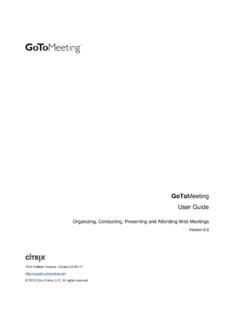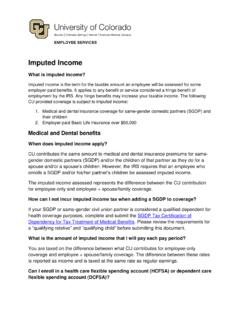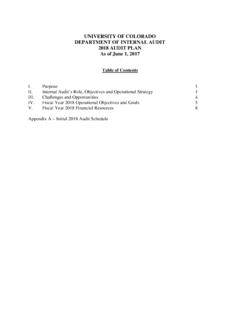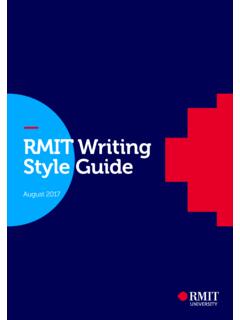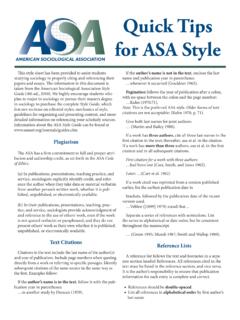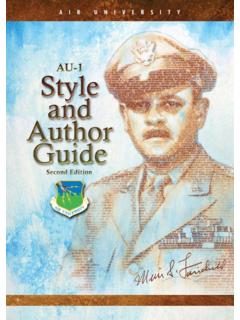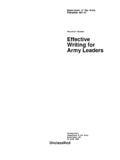Transcription of Style Guide for Writing Online Custom Courses
1 Style Guide for Writing Online Custom Courses Style Guide for Writing Online Custom Courses Copyright May 2012, Office of the President. Employee Learning and Development. 2 Introduction Web-based learning has become an integral component of most training programs because it is scalable and provides an economic advantage over classroom based training, offering flexibility, efficiency and consistency. An effective Online course optimizes content for enhanced learning. This requires rigorous planning and design. The course designer works to ensure that each component of the course presents the learning material in an effective and efficient manner. This Style Guide is intended for Online course designers, outlining good practices for Writing instructional material for Web-based training, including: The D5 instructional design process Specific tasks and products from the design process Best practices for Writing an Online course This Style Guide assumes that Courses will be designed for use Online through SkillSoft for University of Colorado employees.
2 However, the Guide is intended to be flexible enough to be useful in other settings, as well. Style Guide for Writing Online Custom Courses Copyright May 2012, Office of the President. Employee Learning and Development. 3 D5 Instructional Design Process CU ELD follows the D5 Instructional Design Process, which involves a cycle of five phases: Discover, Define, Design, Develop and Deliver. Evaluation (or review and revision) occurs through out the process, between and within each of the phases. Here is a closer look at each of the five phases: 1. Discover: the initial planning phase of the course , which involves meetings between SME and course designer, compilation of content and resources and establishment of project timeline 2.
3 Define: sorting and refining information collected during the Discover phase, which involves establishing a project plan, identifying objectives and preliminary sequencing of the content 3. Design: develop plans for the course , including storyboards, sketches, templates and assessment prototypes 4. Develop: refine the design plans from the previous stage and begin to create the beta-testing version of the course and all its components 5. Deliver: revise the beta version based on feedback from stakeholders and launch the finished course Style Guide for Writing Online Custom Courses Copyright May 2012, Office of the President. Employee Learning and Development. 4 D5 Instructional Design Process (continued) The chart below summarizes the specific tasks and products of each of the five phases.
4 The Input row identifies items, actions or products that are required to make each phase happen. Actions are the tasks that define each phase. Finally, the Output row identifies the products of each phase. Note that products in Output often become the Input items in the subsequent phase. Unless an item must be finalized and approved (marked with an asterisk) at the end of a phase, it will most likely need to be reviewed and revised in the next phase. Discover Define Design Develop Deliver Input SME content Resources Learning Needs Analysis (LNA) tool Project plan Content map or outline course script Summative assessment Beta course Actions LNA Identify course goals Compile content and resources Identify learning and performance objectives Analyze content Block and sequence content Select toolbox items Design appearance Prototype assessments/ practice exercises Design or select media, narratives, etc.
5 Record and edit multimedia Finalize script, images, links, handouts, etc. Coding Beta testing Feedback and final edits Output LNA report* Statement of work (SOW)* Project plan (timelines, roles, scope, etc) Content map or outline Learning and performance objectives* course script* Summative assessment* Beta course Final course launch* Review/Revise *Indicates completed items needing sign-off. Style Guide for Writing Online Custom Courses Copyright May 2012, Office of the President. Employee Learning and Development. 5 Discover: Learning Needs Analysis Before planning a course can begin, course designers must understand the audience and training needs. Specifically, designers need to be able to answer questions such as: Why is this course needed?
6 Who is the course for? What short and long term results are expected or desired? During the Learning Needs Analysis (LNA), the designer and content expert work together to answer these questions and develop a framework for meeting the learning needs of the audience and the business needs of the organization. The table below, contains a representative list of questions to ask during the LNA. (See Addendum 2: Learning Needs Analysis) Learning Needs Analysis (LNA) What is the business need? What problem will the training solve? Is the course required? If so, how often? When must it be completed? Is this training currently being offered? If so, in what format? Is user feedback available? What is working or not working in the current training?
7 What is the reason for the course ? What do learners need to know by the end of the course ? What are the desired learning outcomes? How will success be determined?What are the course goals? Who is the training intended for? How many people will take the course ? What prior knowledge or experience with the subject matter are participants expected to have?Who is the training audience? Style Guide for Writing Online Custom Courses Copyright May 2012, Office of the President. Employee Learning and Development. 6 Define: Goals and Learning Objectives After the LNA and compiling all content and resources , the next step in planning a course is to identify the goals and learning objectives that describe what learners will be able to do at the end of instruction.
8 Goals and objectives differ in that goals are broad and general while objectives are narrow, tangible and precise. In other words, the goal of a course identifies what the short and long term results of the training will be, both for the learners and for the organization. The learning objectives identify specifically what learners need to know or be able to do after taking the course . Learning objectives clearly communicate the intent of instruction and can be validated by assessment. Objectives are learner focused; in other words, they identify behaviors that the learner should adopt after taking the course , rather than focusing on what the course will teach . A true objective can be broken down into two essential parts: Audience Who will be doing the learning?
9 Learners will .. Employees will .. Behavior What the learner will be able to do? ..apply mathematical formulas to excel spreadsheets..identify hazardous wastes. Note that the behaviors in the examples are actions that learners should be able to demonstrate. A good course actively involves the learner. A list of common verbs used in Writing objectives is available in Addendum 1. Style Guide for Writing Online Custom Courses Copyright May 2012, Office of the President. Employee Learning and Development. 7 Design: Plotting the course Once the learning objectives are identified, it s time to build the course . The course objectives will be the foundation for the structure of the course . Objectives and assessment questions will help determine what information goes into the course modules and what goes into handouts or resources.
10 Content should be arranged into a logical sequence so that topics flow smoothly from one to the other in a meaningful way. Content is blocked into modules: thematic units within the course , each with its own learning objectives derived from the course objectives. An effective way to achieve a meaningful and memorable structure is to : 1. Introduce the topic and the learning objectives for the course 2. Present the content 3. Summarize the content 4. Review the content in each module with questions or an activity 5. Test the learners understanding of the whole course with a summative assessment (quiz). This structure can be repeated throughout the course in each of the modules. The only difference between the course and the module structure is that at the end of each module, you will not necessarily test the learners understanding with an assessment.


